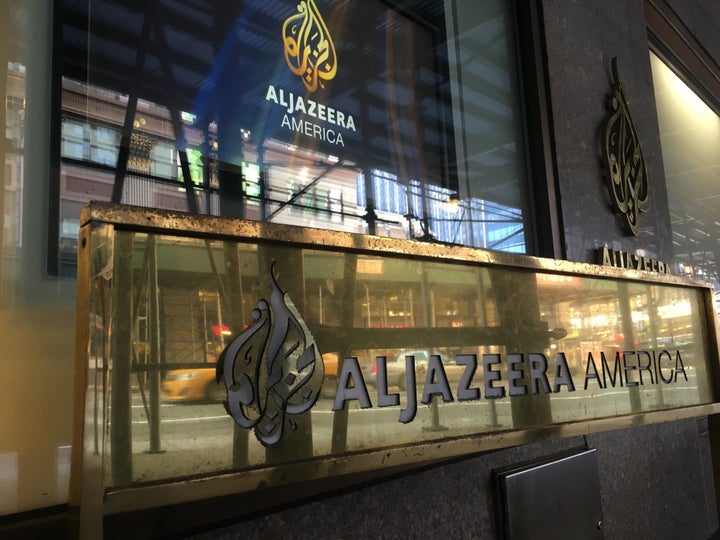
The former New York City headquarters of Al Jazeera America, as seen on February 26, 2016.
Journalists, viewers yearn for replacement, 1 year after network announced closing
Most of my former colleagues have continued their professional media journeys with other organizations, but many wax nostalgic about the huge oasis of opportunity we enjoyed at Al Jazeera America (AJAM).
Some journalists and editors, including myself, have cobbled together freelance gigs but not really moved on to gainful employment at the same level as the now-defunct channel that went off the air last April 12.
Our AJAM corporate leadership declared on January 13, 2016, that the channel would be shuttered within three months. The termination process beginning on that fateful day eventually saw us wind down the startup network in the same ballroom of the New Yorker Hotel in Midtown Manhattan where Hillary Clinton would later deliver her presidential election concession speech on November 9.
Without diving into specifics about where AJAM folks are today, or the current status of Al Jazeera English in the United States, I’d like to revisit the main reasons why AJAM TV failed, with the benefit of 365 days’ hindsight. After that, looking forward, I’ll articulate key areas of our media landscape where a vacuum remains:
Arab Spring collapse
In my view, the biggest factor in AJAM’s decline was the death of the Arab Spring. The grand Qatari vision for “new Middle East” simply did not materialize.
There were big hopes that the 2011 uprising in Cairo, which was broadcast by Al Jazeera English to a massive American online audience, would cause a domino effect of democratization and liberalization throughout the Arab World. Al Jazeera’s expanded presence in America capitalized on this idea that Western audiences took great interest in the masses overthrowing the shackles of authoritarian dictatorship, and the promise that more freedom meant a better life for common people.
But beyond the stability of Gulf monarchies and to a lesser extent, Tunisia, the tarnished legacy of the Arab Spring effectively doomed a media network intimately tied to its practical and ideological success. ISIS, refugees, and despair replaced hope and change.
Depressed oil prices
Although the first factor was largely intangible, the second reason is very tangible. Since Qatar is massively reliant on revenue from petroleum deposits, the commodity prices of oil and natural gas have a major influence on government spending. Al Jazeera, a state-owned media conglomerate, thus requires budgetary largesse from the country’s ruler to prosper.
Looking at the change in oil prices over time, a barrel went from about $50 at the beginning of 2015 to less than $30 at the beginning of 2016, precisely when the board of AJAM decided in a jiffy to cut off funding for the soft-power, vanity project. Oil prices have indeed returned to around $50, but this level indicates far less capacity by fossil fuel-dependent societies to spend on discretionary programs. When AJAM was first conceived in January 2013, oil was over $100 per barrel.
Very low ratings
With TV viewership numbers at rock bottom, the investment in expensive cable contracts could never pay off. The value of Al Jazeera’s original purchase of Al Gore’s Current TV hinged on ostensibly lucrative deals with carriers like Time Warner and Verizon, but without eyeballs, distribution contracts were worthless.
Even with the 60 million households that could ultimately tune in, the active Nielsen viewer base never grew to much more than the tens of thousands. Without a chance of becoming a commercially viable venture, the approximately $2 billion expenditure could not be justified and continued.
The reality of the highly competitive American 24-hour cable news market is that a new player owned by a foreign petro-state has a huge ratings hill to climb. Penetration of the crowded field isn’t easy for any serious, sober contender, not to mention one run by a Middle Eastern nation viewed ambivalently by most Americans.
“At heart, the Arab, Muslim news organization faced a tremendously difficult branding challenge in a society where all trusted, established news brands are pretty much just American.”
Identity crisis
At heart, the Arab, Muslim news organization faced a tremendously difficult branding challenge in a society where all trusted, established news brands are pretty much just American. Even for the BBC and France24, from Western European allies, or RT and CCTV, the Russian and Chinese state broadcasters, which don’t get slapped with the “Al Qaeda TV” moniker, low popularity means stiff resistance to significant audience growth.
Did AJAM want to be more “American”, or more “Al Jazeera”? The channel strove for a balanced combination of both, a perfect equilibrium of the two influences. But in a highly charged geopolitical climate where hot-button issues could set off existential debates on sensitive topics like Israel-Palestine, the network’s DNA was too unstable to survive.
On the other hand, the success of AJ+ in the online video space has been notable because its logo connotes something positive, an addition, more reminiscent of a Swiss icon or Christian cross than the calligraphic symbol perceived as a flaming, terrorist tear drop in the desert. Moreover, AJAM never figured out how to position itself. Would it be a mainstream U.S. corporate presence, or present a fresh, alternative perspective based on a more critical and cosmopolitan orientation? That’s ultimately the niche where AJAM received acclaim for both digital and analog coverage.
Widespread mismanagement
With a CEO who alienated the bulk of 800 employees and key hires who arguably didn’t make much sense beyond tokenism, the company wasn’t on solid footing. From statements about bankrupting the number-one on-air personality to threats against lowly producers, the chief was widely feared and loathed. This might have been okay, if huge legal problems weren’t also part of the picture.
AJAM saw lawsuits by executives alleging gender discrimination and managers complaining of anti-Semitism — as well as the former U.S. vice president from whom the network was initially bought claiming fraud through an escrow account for indemnification. The constant menace of litigation, with the goal of extracting money from the wealthy benefactor and calling attention to political fouls, was crippling. Professional baseball players ultimately joined the chorus of plaintiffs suing a company whose general counsel, it turns out, wasn’t actually admitted to the bar.
“At this point, access to comprehensive and innovative reporting on under-covered parts of the planet, in addition to an outside perspective on earth-shattering events here at home, would be invaluable.”
Given the gradual yet inevitable downfall of the channel over a long period, it’s easy to express fondness for the well-funded journalistic endeavor in an era when most organizations are slashing editorial jobs.
That being said, let’s indulge for a few moments, and I’ll give a few big reasons why we could use some kind of equivalent or replacement to Al Jazeera America in 2017:
‘Fake news’ counterweight
In the age of Donald Trump, it seems like AJAM would have yet greater difficulty staying alive. If any source were going to be frozen out, it would likely be one of the first. However, that would also make the station a valuable resource for speaking truth to power, and holding the new U.S. administration to account.
There’s an alternative universe assuming control right now, and AJAM would be uniquely able to offer a hard news backstop in stark contrast to the tired whiny refrains of left-leaning publications, normalizing attitudes of mainstream content providers, obsequious pro-Trump reporting on the right, and lastly, the blatantly fake news outlets floating hoaxes and conspiracy theories.
Voice of the voiceless
From vulnerable populations in Appalachia to the ghettos of the Rust Belt, AJAM was up to the task of telling the stories that needed to be aired. We were in West Virginia, and Flint, following the narrative well after the other crews had disappeared and lost interest.
Whether covering mining disasters or environmental catastrophes, the assumption was that we had the knowledge and resources to be on the scene. With a commitment to providing “in-depth, fact-based news,” perhaps we were overly ambitious. But the mission was noble, and so many of the pieces had fallen into place for a sustainable news operation.
The gist of our calling was to highlight Native American concerns avoided by other organizations, focus on marijuana and LGBT issues even before they reached major milestones, and explain the roots of economic inequality prior to the watershed election in which populism became the cause celebre of the nation. Enterprise features on race, immigration, and gender have never been more necessary than in 2017.
Global perspective
Hillary Clinton called Al Jazeera “real news” in March 2011 during testimony to Congress, a speech that led my grandmother to take back her statement that I might end up on the “wrong side of history” by working for the Middle East news giant. Clinton, then Secretary of State, implied that the Obama White House’s strategic goals were consistent with the way that Al Jazeera was depicting its home region. So it’s clear that there was an alignment of geopolitical interests, and ultimately this was what gave birth to Al Jazeera America.
Although in many ways Al Jazeera no longer can be relied on for the most accurate and impartial reporting from that part of the world, due to the political alignment of its sponsors, at one time it certainly represented a maximum of high-quality information on so many situations in the Middle East. Yet Americans would benefit tremendously from a better range of news sources than are currently available on the forgotten war in Syria and the endless conflict in Yemen.
At this point, access to comprehensive and innovative reporting on under-covered parts of the planet, in addition to an outside perspective on earth-shattering events here at home, would be invaluable.
So the conclusion here is that the lucky assortment of factors that led to Al Jazeera’s genesis likely won’t ever be repeated. The network took advantage of a generous window of opportunity, but sadly there was a mismatch between the old-school format and the demographic of would-be viewers online. Many critics have simply argued that Al Jazeera gambled on the wrong medium.
Despite the channel’s political, structural, and financial shortcomings, America now desperately needs something similar to pioneer this new era of uncertainty and misinformation. Honest media, robust analysis, and diverse opinions are crucial when the truth is being crucified.
